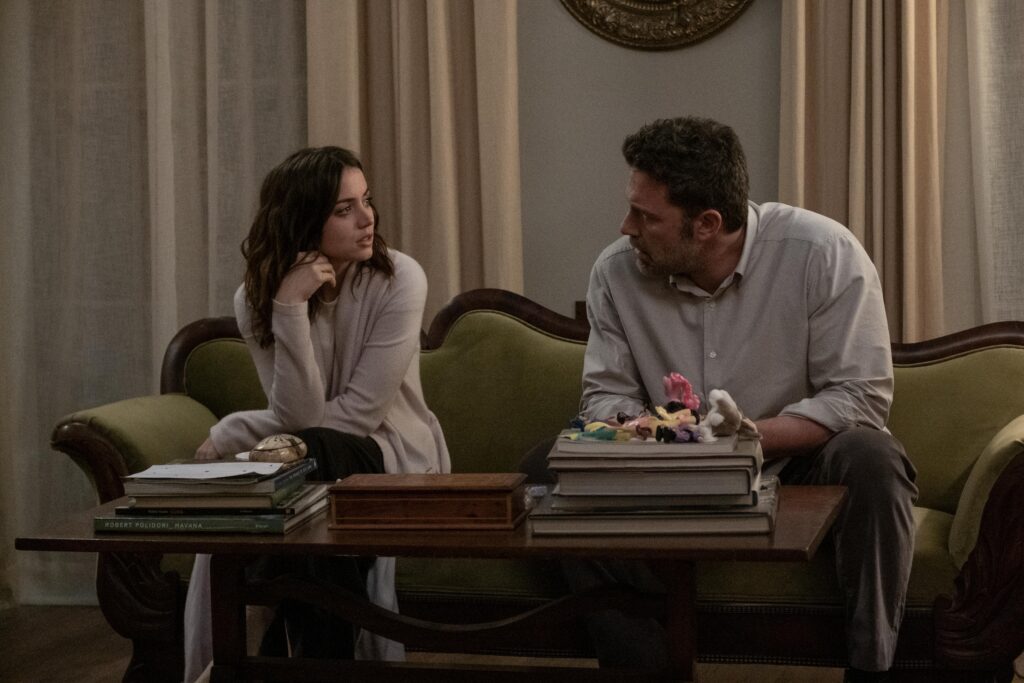September 17, 2022
by Carla Hay

Directed by Andrew Dominik
Culture Representation: Taking place primarily in the Los Angeles area, from 1933 to 1962, the dramatic film “Blonde” features an all-white cast of characters representing the working-class, middle-class and wealthy.
Culture Clash: After a troubled childhood being abused by her mentally ill single mother, Norma Jeane Mortenson becomes a superstar actress named Marilyn Monroe, but her personal demons haunt her and lead to a life of failed romances, drug addiction and unfulfilled wishes to become a mother.
Culture Audience: “Blonde” will appeal mainly to people who are fans of Marilyn Monroe and “Blonde” star Ana de Armas, as well as anyone who has a tolerance for seeing movies that show the very dark sides of fame and Hollywood.

Marilyn Monroe Trauma Porn is a more accurate title for this very divisive drama, which blurs fact and fiction, with mixed results. Ana de Armas’ risk-taking, tour-de-force performance (which still has some flaws) is the main reason to watch when this bloated movie drowns in its own tacky pretension. How tacky and pretentious can “Blonde” be?
In real life, legendary actress Marilyn Monroe desperately wanted to become a mother but never achieved her dream of having children because of she had miscarriages and abortions. In “Blonde,” there’s a scene showing a doomed, talking fetus inside Monroe’s body—one of several fetus scenes in the movie. The movie also has multiple bloody and graphic scenes of some of these miscarriages and abortions. In de Armas’ striking performance as Monroe, “Blonde” wants viewers to viscerally react to the kind of pain Monroe went through in her life, no matter how uncomfortable it is to watch.
“Blonde” (written and directed by Andrew Dominik) has some stunning and poignant scenes that are meant to shock people or wrench viewers’ emotions out of their hearts. The movie, which had its world premiere at the Venice International Film Festival in Italy, randomly alternates between scenes in color and scenes in black and white. There isn’t a bad performance in “Blonde,” but de Armas is the cast member who undoubtedly elevates the movie the most.
“Blonde” isn’t all gloom and doom, since it also artfully and faithfully recreates many of Monroe’s most iconic movie movements. They include Monroe performing “Diamonds Are a Girl’s Best Friend” in 1953’s “Gentlemen Prefer Blondes” and Monroe’s famous scene from 1955’s “The Seven Year Itch,” where she stands on a New York City subway grate, and the air gusts from below make the white dress that she’s wearing billow up around her and expose her underwear.
Still, the biggest shortcoming of “Blonde” is that it relentlessly presents Monroe as a trauma victim, when she was actually a much more well-rounded person in real life. (Monroe died in her Los Angeles home of a barbiturate overdose in 1962, at the age of 36.) “Blonde” is based on Joyce Carol Oates’ 2000 novel of the same name. The novel was also adapted into a two-episode miniseries, which was televised on CBS in 2001, with Poppy Montgomery in the role of Monroe.
The “Blonde” movie and the “Blonde” miniseries are very different from each other. The “Blonde” minseries was middling and unremarkable. The “Blonde” movie goes to extremes that some viewers think go too far. The Motion Picture Association of America gave “Blonde” movie a rare NC-17 rating (prohibiting people under the age of 17 from seeing the movie in U.S. theaters), because of the movie’s sexual content. However, “Blonde” never actually shows full-frontal male nudity (one of the main reasons why movies can get the NC-17 rating) but shows de Armas simulating sex acts that could be disturbing to some viewers.
The “Blonde” novel was also very controversial, even though the “Blonde” movie and book are clearly labeled as works of fiction. The story draws from many facts about Monroe’s life but fabricates many of the hallucinatory sequences, conversations and experiences that are based on speculation on what she could have said and done if she were really in those situations. It’s this speculation that seems to irk people the most, but that seems to be a problem for people who don’t know or who forgot that “Blonde” is labeled a work of fiction.
For example, in real life, when Monroe was a starlet in the late 1940s, there were rumors that she was dating Charlie Chaplin Jr., as reported in the media back then. In Dominik’s “Blonde” movie, this relationship is turned into a three-way romance between Marilyn, Charlie “Cass” Chaplin Jr. (played Xavier Samuel) and Edward G. “Eddy” Robinson Jr. (played by Evan Williams), where they engage in sexual threesomes. It’s one of the few times in the movie where Marilyn seems to be truly happy. (For the purposes of this review, the “Blonde” protagonist character is referred to as Marilyn or Norma Jeane, while the real-life Monroe is referred to as Monroe.)
There have been so many books, news reports, feature articles, impersonators and on-screen portrayals of Monroe, it’s almost impossible for anyone who knows about pop culture not to know something about her. People already have their opinions of Monroe and expectations of how she should be portrayed in anything that could be considered biographical. One of the frustrations of the “Blonde” movie is that this 166-minute film drags on for too long and keeps repeating certain scenarios while leaving out important aspects of Monroe’s life.
For example, the movie’s early scenes show the horrific abuse that Marilyn (then known by her birth name, Norma Jeane Mortenson) endured as a child, but does not show any other aspect of her childhood, such as her education or who her childhood friends were. “Blonde” shows Norma Jeane as a 7-year-old, portrayed by Lily Fisher. Norma Jeane’s mentally ill, single mother Gladys (played by Julianne Nicholson) would beat her, strangle her and once attempted to drown her in a bathtub. Gladys was eventually put in a mental health institution, and Norma Jeane spent the rest of her childhood in foster care.
In these childhood abuse scenes, three themes emerge that are repeated throughout the rest of the movie. The first theme is that Norma Jeane/Marilyn pines for her absent father, whom she never knew. Gladys would tell Norma Jeane and other people stories about Norma Jeane’s father being a “titan of the industry” (what industry, Gladys would never say), when in all probability, he was just an anonymous deadbeat dad. Throughout most of her life, Norma Jeane imagined that her father (who’s heard in a voiceover) would write loving letters to her and promise to reunite with her some day. This fantasy contradicts what Gladys would tell Norma Jeane when Gladys would fly into a rage: Norma Jeane’s father left Gladys because Gladys got pregnant with Norma Jeane.
The second theme uses fire as a visual manifestation of Marilyn’s inner torment. An early scene shows an intoxicated and apparently manic Gladys insisting on driving through a California wildfire, with Norma Jeane as a terrified passenger. Gladys gets agitated when she’s stopped by a police officer, who orders her to go back home. The house ends up catching on fire. There are also recurring images of Norma Jeane/Marilyn walking through a burning building.
The third theme has to do with turmoil over caring for an infant. Gladys tells 7-year-old Norma Jeane that when Norma Jeane was a baby, Gladys couldn’t afford a crib, so she would put Norma Jeane in a dresser drawer to sleep. For the rest of the movie, there are images of Marilyn being haunted by the sounds of a baby crying in a dresser drawer. She tends to experience these hallucinations shortly before or after one of her pregnancies ends in heartbreak for her.
With repetition of these themes during depictions of Marilyn’s failed romances, “Blonde” curiously omits any mention of her first marriage: In real life, Monroe married factory worker-turned-merchant-Marine James Dougherty in 1942, when she was 16. The marriage ended in divorce in 1946, when up-and-coming actress Monroe was on the cusp of major fame.
She would then get married and divorced two more times. Her second husband was to retired baseball star Joe DiMaggio (played by Bobby Cannavale), whose “Blonde” movie character is named The Ex-Athlete. Their marriage, which lasted from 1954 to 1955, was reportedly plagued by his physical abuse to her. Her third and last husband was writer Arthur Miller (played by Adrien Brody), whose “Blonde” movie character is named The Playwright. In real life, Monroe and Miller were married from 1956 to 1961, during the years when her drug addiction worsened.
“Blonde” also portrays Marilyn’s volatile experiences filming director Billy Wilder’s 1959 comedy “Some Like it Hot” (co-starring Jack Lemmon and Tony Curtis), with Marilyn and Billy Wilder (played by Ravil Isyanov) clashing with each other, on and off the movie set. The expected Marilyn meltdowns are depicted, with enablers always nearby and ready to give injections or pills to Marilyn, in order to prop her up and keep her working.
In the last few years of her life, Marilyn’s sexual relationship with then-U.S. president John F. Kennedy is depicted as superficial, at least on his part. “Blonde” only lists this character’s name as The President (played by Caspar Phillipson), but it’s obviously supposed to be Kennedy. Marilyn seems to have romantic feelings for him but is afraid to express them, out of fear of not wanting to look like a clingy mistress. When she is literally carried by two aides to President Kennedy’s hotel room for a tryst, an intoxicated Marilyn asks, “Am I room service?” It’s sarcasm with some truth.
Marilyn gives President Kennedy oral sex in a scene that actually has no nudity. But because he calls her a “dirty whore” during this sex act, it’s meant to be entirely degrading for her. At one point, he grabs her by the hair and pushes her, and the movie abruptly cuts to the next scene. Whether or not this aggressive pushing resulted in rape is open to debate, but “Blonde” doesn’t show President John F. Kennedy raping Marilyn Monroe, no matter what some uninformed reports about the movie would suggest.
“Blonde” makes it look like, except for her mother Gladys, the people who repeatedly abused and exploited Marilyn were predatory men, including the unnamed studio executive who gave Marilyn her first big break. The sex scene with him (his face is never shown) can be interpreted as rape or “casting couch” sexual harassment. However, critics of “Blonde” certainly can find unintentional irony in a movie that seems to condemn men who exploit women in the entertainment industry, when “Blonde” (written and directed by a man) can also be interpreted as continued exploitation of Monroe.
The difference in this Monroe quasi-biopic is that de Armas clearly took extra care and control in how she portrayed Norma Jeane/Marilyn, and de Armas added many emotional layers that are not often seen in other on-screen portrayals of Monroe. In her portrayal of Norma Jeane/Marilyn, de Armas shows every range of emotion and makes the audience feel these emotions in several scenes that are sure to nauseate or repulse some viewers. However, de Armas (who is originally from Cuba) is not flawless in her accent work for Marilyn, since her Cuban accent sometimes can be heard in some scenes. This accent inconsistency is a distraction, but it doesn’t ruin the movie.
“Blonde” is one of those movies where the star gives a very memorable and harrowing performance, but most viewers probably will not want to see this movie more than once. Before seeing “Blonde,” many viewers will already know that underneath the glitz and glamour, the real-life Monroe often had a sad, lonely and troubled life. All of that is important to point out, which “Blonde” does almost to a fault. In trying not to over-sanitize Monroe’s story, “Blonde” goes in the complete opposite direction and will make a lot of viewers feel like this story is too dirty and sullies Monroe’s legacy.
Netflix released “Blonde” in select U.S. cinemas on September 16, 2022. The movie is set to premiere on Netflix on September 28, 2022.












